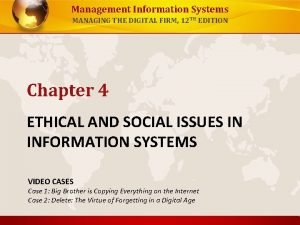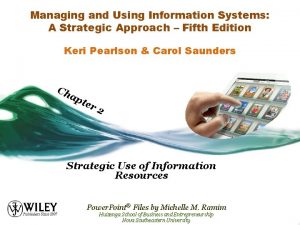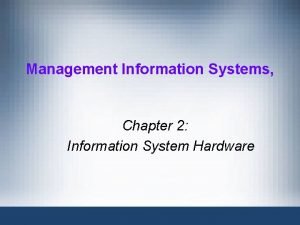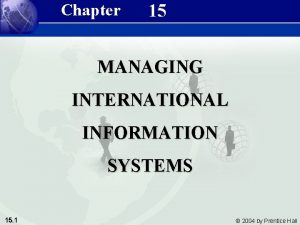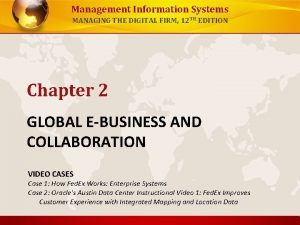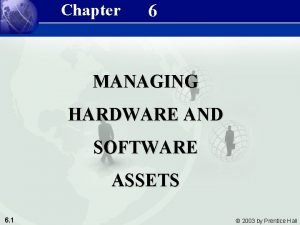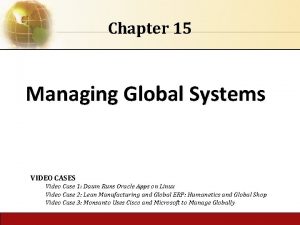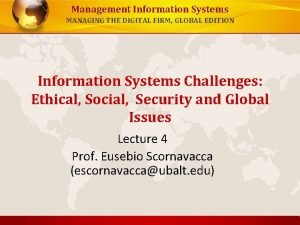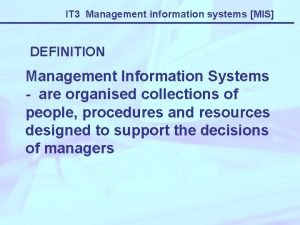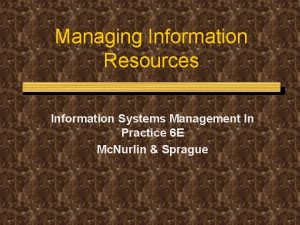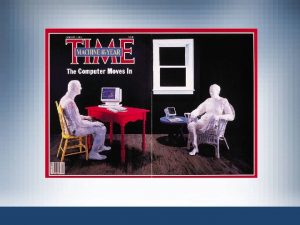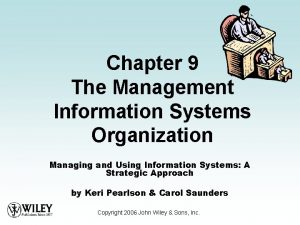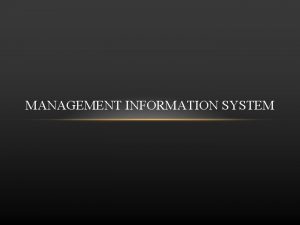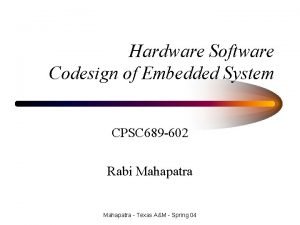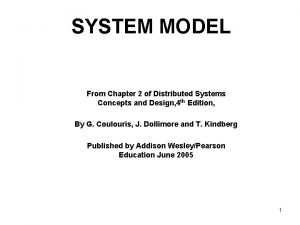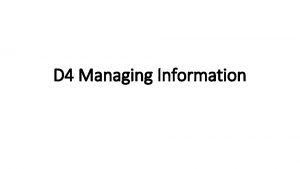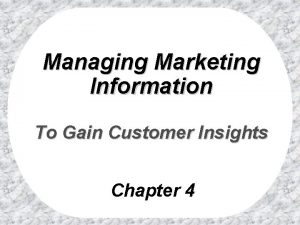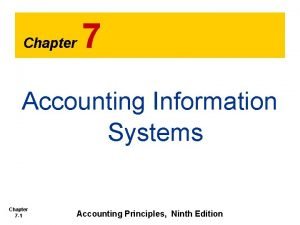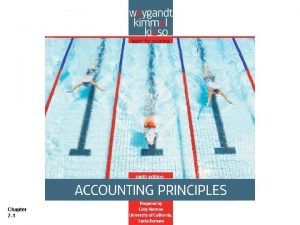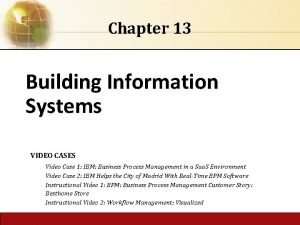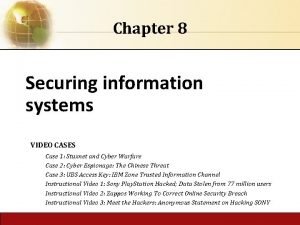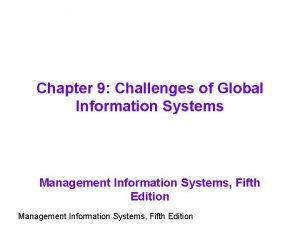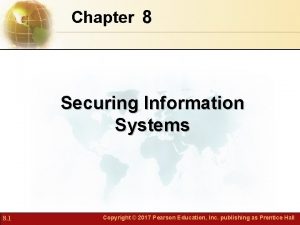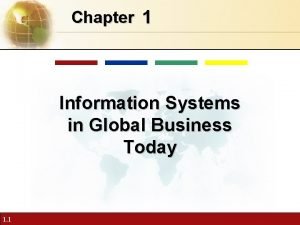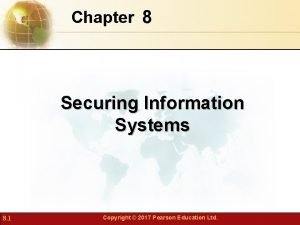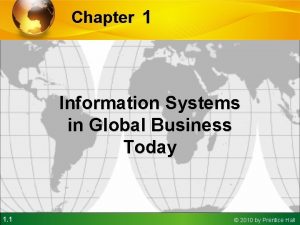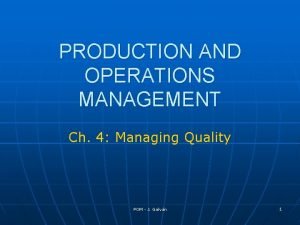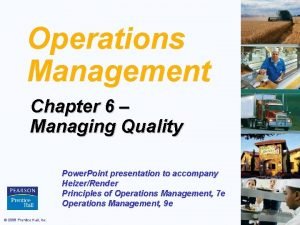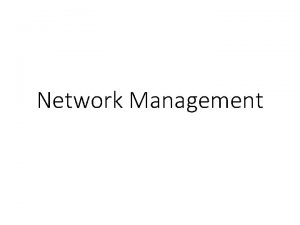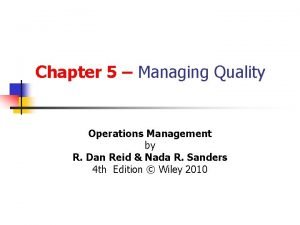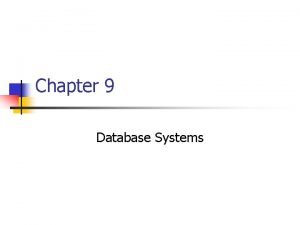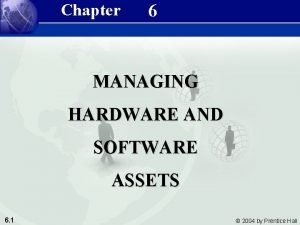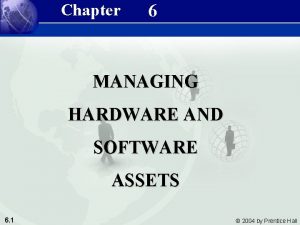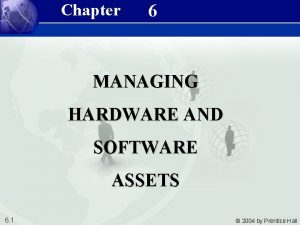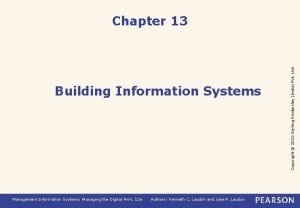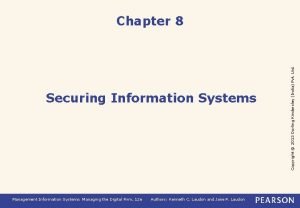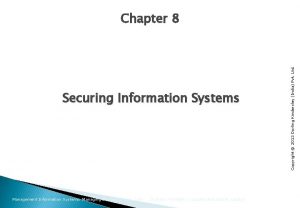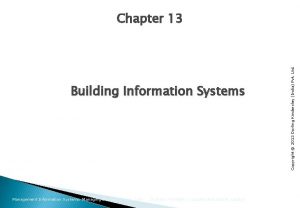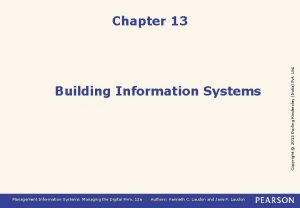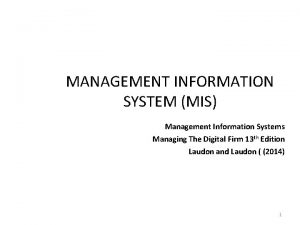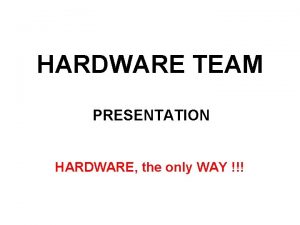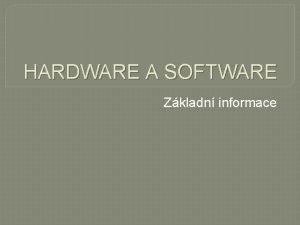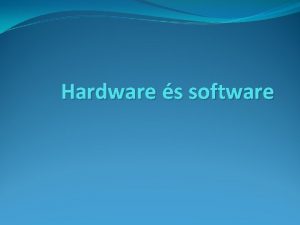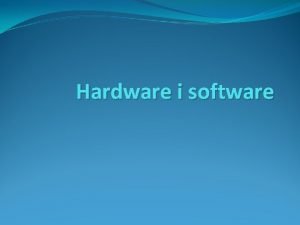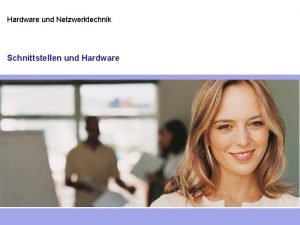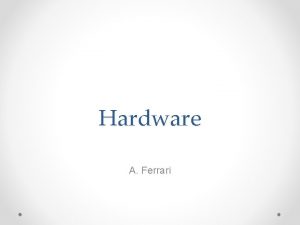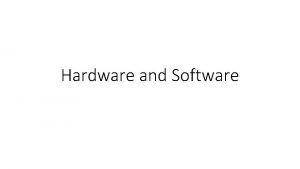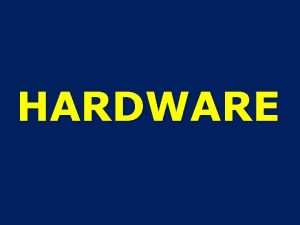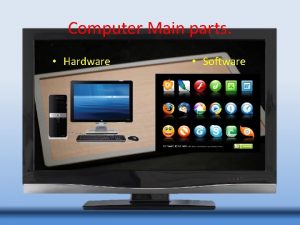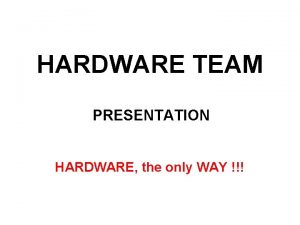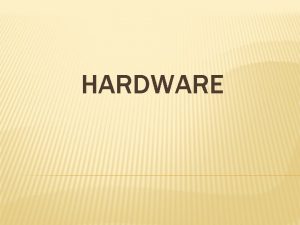Management Information Systems 8e Chapter 6 Managing Hardware

























































- Slides: 57

Management Information Systems 8/e Chapter 6 Managing Hardware and Software Assets MANAGING HARDWARE AND SOFTWARE ASSETS 6. 1 © 2004 by Prentice Hall

Management Information Systems 8/e Chapter 6 Managing Hardware and Software Assets OBJECTIVES • What computer processing and storage capability does our organization need to handle its information and business transactions? • What arrangement of computers and computer processing would best benefit our organization? • What kinds of software and software tools do we need to run our business? What criteria should we use to select our software technology? 6. 2 © 2004 by Prentice Hall

Management Information Systems 8/e Chapter 6 Managing Hardware and Software Assets OBJECTIVES • Of what new software technologies should we be aware? How would they benefit our organization? • How should we acquire and manage the firm’s hardware and software assets? 6. 3 © 2004 by Prentice Hall

Management Information Systems 8/e Chapter 6 Managing Hardware and Software Assets MANAGEMENT CHALLENGES 6. 4 • The centralization versus decentralization debate • The application backlog © 2004 by Prentice Hall

Management Information Systems 8/e Chapter 6 Managing Hardware and Software Assets COMPUTER HARDWARE AND INFORMATION TECHNOLOGY INFRASTRUCTURE Hardware Components of a Computer System Figure 6 -1 6. 5 © 2004 by Prentice Hall

Management Information Systems 8/e Chapter 6 Managing Hardware and Software Assets COMPUTER HARDWARE AND INFORMATION TECHNOLOGY INFRASTRUCTURE The Computer System Bit • Binary digit • Represents smallest unit of data in the form of either 0 or 1 Byte 6. 6 • String of bits, usually eight • Stores one number or character © 2004 by Prentice Hall

Management Information Systems 8/e Chapter 6 Managing Hardware and Software Assets COMPUTER HARDWARE AND INFORMATION TECHNOLOGY INFRASTRUCTURE Bits and Bytes 0 or 1 One bit Characters are represented by one byte for each letter. 0 1 0 0 0 1 6. 7 One byte for character A Figure 6 -2 © 2004 by Prentice Hall

Management Information Systems 8/e Chapter 6 Managing Hardware and Software Assets COMPUTER HARDWARE AND INFORMATION TECHNOLOGY INFRASTRUCTURE The CPU and Primary Storage Central Processing Unit (CPU) 6. 8 • Manipulates symbols, numbers, and letters • Controls other parts of the computer system © 2004 by Prentice Hall

Management Information Systems 8/e Chapter 6 Managing Hardware and Software Assets COMPUTER HARDWARE AND INFORMATION TECHNOLOGY INFRASTRUCTURE The CPU and Primary Storage 6. 9 • Temporarily stores program instructions • Data being used by the instructions © 2004 by Prentice Hall

Management Information Systems 8/e Chapter 6 Managing Hardware and Software Assets COMPUTER HARDWARE AND INFORMATION TECHNOLOGY INFRASTRUCTURE The CPU and Primary Storage 6. 10 Figure 6 -3 © 2004 by Prentice Hall

Management Information Systems 8/e Chapter 6 Managing Hardware and Software Assets COMPUTER HARDWARE AND INFORMATION TECHNOLOGY INFRASTRUCTURE Primary Storage Stores 6. 11 • Software program being executed • Operating system programs • Data being used by program © 2004 by Prentice Hall

Management Information Systems 8/e Chapter 6 Managing Hardware and Software Assets COMPUTER HARDWARE AND INFORMATION TECHNOLOGY INFRASTRUCTURE CPU 6. 12 • Arithmetic-logic unit (ALU): performs the computer’s principal logic and arithmetic operations • Control Unit: coordinates and controls the other parts of the computer system © 2004 by Prentice Hall

Management Information Systems 8/e Chapter 6 Managing Hardware and Software Assets COMPUTER HARDWARE AND INFORMATION TECHNOLOGY INFRASTRUCTURE Primary Storage 6. 13 • RAM: Directly accesses any randomly chosen location in the same amount of time • ROM: Semiconductor memory chips with program instructions, cannot be written to © 2004 by Prentice Hall

Management Information Systems 8/e Chapter 6 Managing Hardware and Software Assets COMPUTER HARDWARE AND INFORMATION TECHNOLOGY INFRASTRUCTURE Computer Processing Microprocessors and Processing Power 6. 14 • Integrated circuit technology • Integrates the computer’s memory, logic, and control on a single chip © 2004 by Prentice Hall

Management Information Systems 8/e Chapter 6 Managing Hardware and Software Assets COMPUTER HARDWARE AND INFORMATION TECHNOLOGY INFRASTRUCTURE Computer Processing Parallel Processing 6. 15 • Problem broken down into smaller parts • Multiple instructions processed simultaneously with multiple processors © 2004 by Prentice Hall

Management Information Systems 8/e Chapter 6 Managing Hardware and Software Assets COMPUTER HARDWARE AND INFORMATION TECHNOLOGY INFRASTRUCTURE Sequential and Parallel Processing 6. 16 Figure 6 -4 © 2004 by Prentice Hall

Management Information Systems 8/e Chapter 6 Managing Hardware and Software Assets COMPUTER HARDWARE AND INFORMATION TECHNOLOGY INFRASTRUCTURE Secondary Storage Technology 6. 17 • Magnetic disk: Floppy disk, Hard disk • Optical disks: CD-ROM, DVDs • Magnetic tape: Inexpensive, older • New storage alternatives: Storage secondary-storage medium Area Networks (SANs) © 2004 by Prentice Hall

Management Information Systems 8/e Chapter 6 Managing Hardware and Software Assets COMPUTER HARDWARE AND INFORMATION TECHNOLOGY INFRASTRUCTURE A Storage Area Network (SAN) 6. 18 Figure 6 -5 © 2004 by Prentice Hall

Management Information Systems 8/e Chapter 6 Managing Hardware and Software Assets COMPUTER HARDWARE AND INFORMATION TECHNOLOGY INFRASTRUCTURE Input and Output Devices 6. 19 © 2004 by Prentice Hall

Management Information Systems 8/e Chapter 6 Managing Hardware and Software Assets COMPUTER HARDWARE AND INFORMATION TECHNOLOGY INFRASTRUCTURE Input and Output Devices 6. 20 © 2004 by Prentice Hall

Management Information Systems 8/e Chapter 6 Managing Hardware and Software Assets COMPUTER HARDWARE AND INFORMATION TECHNOLOGY INFRASTRUCTURE Batch and On-Line Input and Processing Batch processing • Transactions accumulated and stored until processing On-line processing • 6. 21 Transactions are entered directly into computer and processed immediately © 2004 by Prentice Hall

Management Information Systems 8/e Chapter 6 Managing Hardware and Software Assets COMPUTER HARDWARE AND INFORMATION TECHNOLOGY INFRASTRUCTURE A Comparison of Batch and On-line Processing 6. 22 Figure 6 -6 © 2004 by Prentice Hall

Management Information Systems 8/e Chapter 6 Managing Hardware and Software Assets COMPUTER HARDWARE AND INFORMATION TECHNOLOGY INFRASTRUCTURE Interactive Multimedia 6. 23 • Integrates two or more types of media into a computer-based application • Used in interactive Web pages with graphics, sound, animation, video © 2004 by Prentice Hall

Management Information Systems 8/e Chapter 6 Managing Hardware and Software Assets CATEGORIES OF COMPUTERS AND COMPUTER SYSTEMS Classifying Computers 6. 24 • Mainframes: Largest computer, massive • Midrange computers: Less powerful, • Server: Provides software and other memory, rapid processing power less expensive, and smaller than a mainframe resources to computers over a network © 2004 by Prentice Hall

Management Information Systems 8/e Chapter 6 Managing Hardware and Software Assets CATEGORIES OF COMPUTERS AND COMPUTER SYSTEMS Classifying Computers 6. 25 • Minicomputers: Middle-range computer, • Server Farm: Large group of servers used in universities, factories, or research laboratories maintained by a commercial vendor, available for electronic commerce and other activities © 2004 by Prentice Hall

Management Information Systems 8/e Chapter 6 Managing Hardware and Software Assets CATEGORIES OF COMPUTERS AND COMPUTER SYSTEMS Classifying Computers 6. 26 • Personal Computer (PC): Small desktop • Workstation: Desktop computer with • Supercomputer: Highly sophisticated or portable computer powerful graphics and mathematical capabilities and powerful, performs complex computations © 2004 by Prentice Hall

Management Information Systems 8/e Chapter 6 Managing Hardware and Software Assets CATEGORIES OF COMPUTERS AND COMPUTER SYSTEMS Computer Networks and Client/Server Computing • Distributed processing: Distribution of processing work among multiple computers • Centralized processing: Accomplished by one large central computer • Client/server computing: Splits processing between “clients” and “servers” on network 6. 27 © 2004 by Prentice Hall

Management Information Systems 8/e Chapter 6 Managing Hardware and Software Assets CATEGORIES OF COMPUTERS AND COMPUTER SYSTEMS Client/Server Computing 6. 28 Figure 6 -7 © 2004 by Prentice Hall

Management Information Systems 8/e Chapter 6 Managing Hardware and Software Assets CATEGORIES OF COMPUTERS AND COMPUTER SYSTEMS Types of Client/Server Computing Figure 6 -8 6. 29 © 2004 by Prentice Hall

Management Information Systems 8/e Chapter 6 Managing Hardware and Software Assets CATEGORIES OF COMPUTERS AND COMPUTER SYSTEMS Network Computers and Peer-to-Peer Computing • Network computer (NC): Simplified desktop computer, does not store data permanently • Peer-to-peer computing: Distributed processing that links computers through Internet or private networks • 6. 30 Grid computing: Applies computational resources of many networked computers to solve a large, complex problem © 2004 by Prentice Hall

Management Information Systems 8/e Chapter 6 Managing Hardware and Software Assets TYPES OF SOFTWARE The Major Types of Software • Software program: Series of statements or instructions to the computer • System software: Generalized programs, manages computer’s resources • Application software: Programs written to perform functions specified by end users 6. 31 © 2004 by Prentice Hall

Management Information Systems 8/e Chapter 6 Managing Hardware and Software Assets TYPES OF SOFTWARE The Major Types of Software 6. 32 Figure 6 -9 © 2004 by Prentice Hall

Management Information Systems 8/e Chapter 6 Managing Hardware and Software Assets TYPES OF SOFTWARE System Software and PC Operating Systems Operating system • System software • Manages and controls computer 6. 33 © 2004 by Prentice Hall

Management Information Systems 8/e Chapter 6 Managing Hardware and Software Assets TYPES OF SOFTWARE System Software and PC Operating Systems Functions of the operating system • Allocates and assigns system resources • Schedules use of computer resources • Monitors computer system activities • Provides locations in primary memory for data and programs • Controls the input and output devices 6. 34 © 2004 by Prentice Hall

Management Information Systems 8/e Chapter 6 Managing Hardware and Software Assets TYPES OF SOFTWARE System Software and PC Operating Systems Multiprogramming • Executes two or more programs concurrently using the same computer • CPU executes only one program but services the input/output needs of others 6. 35 © 2004 by Prentice Hall

Management Information Systems 8/e Chapter 6 Managing Hardware and Software Assets TYPES OF SOFTWARE System Software and PC Operating Systems Multitasking • Multiprogramming capability of singleuser operating systems Virtual Storage • Handles programs more efficiently by dividing the programs into small fixed or variable length 6. 36 © 2004 by Prentice Hall

Management Information Systems 8/e Chapter 6 Managing Hardware and Software Assets TYPES OF SOFTWARE System Software and PC Operating Systems Time Sharing • Sharing of computer resources by many users simultaneously Multiprocessing • Executing two or more instructions simultaneously in a single computer using multiple central processing units 6. 37 © 2004 by Prentice Hall

Management Information Systems 8/e Chapter 6 Managing Hardware and Software Assets TYPES OF SOFTWARE System Software and PC Operating Systems Language translation and utility software • Translates high-level language programs into machine language 6. 38 © 2004 by Prentice Hall

Management Information Systems 8/e Chapter 6 Managing Hardware and Software Assets TYPES OF SOFTWARE PC Operating Systems and Graphical User Interfaces • GUIs in contemporary PC operating systems • Windows XP • Microsoft’s Windows 98 and Me • Windows 2000 6. 39 © 2004 by Prentice Hall

Management Information Systems 8/e Chapter 6 Managing Hardware and Software Assets TYPES OF SOFTWARE PC Operating Systems and Graphical User Interfaces • Windows. NET server • UNIX • Linux: open-source software 6. 40 © 2004 by Prentice Hall

Management Information Systems 8/e Chapter 6 Managing Hardware and Software Assets TYPES OF SOFTWARE Application Software and Programming Languages • Programming languages: evolved from machine language to high-level languages for business and scientific work • Important programming languages for business today: COBOL, C, C++, and Visual Basic 6. 41 © 2004 by Prentice Hall

Management Information Systems 8/e Chapter 6 Managing Hardware and Software Assets TYPES OF SOFTWARE Fourth-Generation Languages • Fourth-generation language: Can help end users develop software with little or no assistance from IS specialists • Natural languages: Close to human language • Query languages: Provide immediate on -line answers to requests 6. 42 © 2004 by Prentice Hall

Management Information Systems 8/e Chapter 6 Managing Hardware and Software Assets CONTEMPORARY TOOLS FOR SOFTWARE DEVELOPMENT Object-Oriented Programming Object-oriented programming • Approach to software development that combines data and procedures into a single object Visual programming • Construction of software programs by selecting and arranging programming objects 6. 43 © 2004 by Prentice Hall

Management Information Systems 8/e Chapter 6 Managing Hardware and Software Assets Class and inheritance Figure 6 -10 6. 44 © 2004 by Prentice Hall

Management Information Systems 8/e Chapter 6 Managing Hardware and Software Assets CONTEMPORARY TOOLS FOR SOFTWARE DEVELOPMENT Java • Programming language • Delivers the software functionality needed for a particular task • Runs on any computer and operating system 6. 45 © 2004 by Prentice Hall

Management Information Systems 8/e Chapter 6 Managing Hardware and Software Assets CONTEMPORARY TOOLS FOR SOFTWARE DEVELOPMENT Hypertext Markup Language (HTML) and XML • Hypertext Markup Language (HTML): Page description language, creates Web pages and other hypermedia documents • XML (e. Xtensible Markup Language): Describes the structure of a document, supports links to multiple documents, allowing data to be manipulated by the computer 6. 46 © 2004 by Prentice Hall

Management Information Systems 8/e Chapter 6 Managing Hardware and Software Assets TYPES OF SOFTWARE Application Software Packages and Productivity Software • PC software tools: Word Processing Software, Spreadsheets, Data Management Software, Presentation Graphics • Other productivity software: e-mail, groupware, Web browsers 6. 47 © 2004 by Prentice Hall

Management Information Systems 8/e Chapter 6 Managing Hardware and Software Assets TYPES OF SOFTWARE Word Processing Software Figure 6 -11 6. 48 © 2004 by Prentice Hall

Management Information Systems 8/e Chapter 6 Managing Hardware and Software Assets TYPES OF SOFTWARE Software for Enterprise Integration Enterprise software • Set of integrated modules for major business functions • Allows data to be used by multiple functions and business processes 6. 51 © 2004 by Prentice Hall

Management Information Systems 8/e Chapter 6 Managing Hardware and Software Assets TYPES OF SOFTWARE Software for Enterprise Integration Middleware • Allows two disparate applications to communicate to exchange data Web server • Manages requests for Web pages on the computer where they are stored 6. 52 © 2004 by Prentice Hall

Management Information Systems 8/e Chapter 6 Managing Hardware and Software Assets TYPES OF SOFTWARE Software for Enterprise Integration Enterprise application integration software • Ties together multiple applications to support enterprise integration 6. 53 © 2004 by Prentice Hall

Management Information Systems 8/e Chapter 6 Managing Hardware and Software Assets MANAGING HARDWARE AND SOFTWARE ASSETS Hardware Technology Requirements for Electronic Commerce and Digital Firm • Capacity planning: Process of predicting the computing power • Scalability: Ability of a computer, product, or system to expand to serve without breaking down 6. 55 © 2004 by Prentice Hall

Management Information Systems 8/e Chapter 6 Managing Hardware and Software Assets MANAGING HARDWARE AND SOFTWARE ASSETS Total Cost of Ownership (TCO) of Technology Assets • Designates the total cost of owning technology resources • Includes initial purchase costs, cost of hardware and software upgrades, maintenance, technical support, and training 6. 56 © 2004 by Prentice Hall

Management Information Systems 8/e Chapter 6 Managing Hardware and Software Assets MANAGING HARDWARE AND SOFTWARE ASSETS Rent or Build Decisions: Using Technology Service Providers On-line storage service providers • Third-party providers that rent out storage space to subscribers over the Web • Allow customers to store and access data • Application service providers (ASPs) • Provide software that can be rented by other companies 6. 57 © 2004 by Prentice Hall

Management Information Systems 8/e Chapter 6 Managing Hardware and Software Assets MANAGING HARDWARE AND SOFTWARE ASSETS Rent or Build Decisions: Using Technology Service Providers Other types of service providers • Management service providers and business continuity service providers Utility computing • “Pay as you go” model” where firms pay only for the information technology resources they actually use during a specified period 6. 58 © 2004 by Prentice Hall

Management Information Systems 8/e Chapter 6 Managing Hardware and Software Assets MANAGING HARDWARE AND SOFTWARE ASSETS VENDOR OPS. CENTER CUSTOMER PREMISES Vendor-supplied portal software gives a customer the same view as the vendor operations center. Firewall Using proprietary software, vendor employees monitor and manage a customer's storage. Vendor's on-site hardware device Storage infrastructure (may be direct-attached storage, SANs or NAS) 6. 59 Figure 6 -15 SECURE NETWORK CONNECTION The customer's actual data never passes through the firewall; rather, metadata needed to manage storage flows across a secure network connection. © 2004 by Prentice Hall

Management Information Systems 8/e Chapter 6 Managing Hardware and Software Assets MANAGING HARDWARE AND SOFTWARE ASSETS 6. 60 © 2004 by Prentice Hall
 Management information systems managing the digital firm
Management information systems managing the digital firm Managing and using information systems
Managing and using information systems Information system hardware
Information system hardware Managing global systems chapter 15
Managing global systems chapter 15 Management information system managing the digital firm
Management information system managing the digital firm Managing hardware and software assets
Managing hardware and software assets Function of information system with diagram
Function of information system with diagram Management information systems chapter 1
Management information systems chapter 1 External components of computer
External components of computer Global systems 1 management
Global systems 1 management Managing global systems
Managing global systems Example of management information systems
Example of management information systems What is management information systems
What is management information systems Information systems management in practice
Information systems management in practice Management information systems 16th edition
Management information systems 16th edition Specialized information systems
Specialized information systems Management information systems wiley
Management information systems wiley Management information systems 13th edition
Management information systems 13th edition Management information systems effy oz
Management information systems effy oz Introduction to management information systems 5th edition
Introduction to management information systems 5th edition Mis meaning
Mis meaning Hardware software codesign in embedded systems
Hardware software codesign in embedded systems Software and hardware service layers in distributed systems
Software and hardware service layers in distributed systems Marketing information and customer insights are
Marketing information and customer insights are Managing information between professionals
Managing information between professionals Information technology resource management
Information technology resource management Using marketing information to gain customer insights
Using marketing information to gain customer insights Managing marketing information
Managing marketing information Chapter 8 securing information systems
Chapter 8 securing information systems Chapter 8 securing information systems
Chapter 8 securing information systems Chapter 7 accounting information systems
Chapter 7 accounting information systems Chapter 7 accounting information systems
Chapter 7 accounting information systems Chapter 13 building information systems
Chapter 13 building information systems Securing information systems
Securing information systems Principles of information systems
Principles of information systems Fundamentals of information systems
Fundamentals of information systems What are the challenges to global information systems
What are the challenges to global information systems Chapter 8 securing information systems
Chapter 8 securing information systems Chapter 4 ethical issues
Chapter 4 ethical issues Information systems in global business today
Information systems in global business today Chapter 4 ethical and social issues in information systems
Chapter 4 ethical and social issues in information systems Chapter 8 securing information systems
Chapter 8 securing information systems Chapter 7 accounting information systems
Chapter 7 accounting information systems Chapter 3 information systems organizations and strategy
Chapter 3 information systems organizations and strategy Information system in global business
Information system in global business Managing quality in operations management
Managing quality in operations management Infrastructure and asset management
Infrastructure and asset management Managing assets vs asset management
Managing assets vs asset management Managing quality in operations management
Managing quality in operations management Managing entity network management
Managing entity network management Public switched telephone network notes
Public switched telephone network notes Managing quality in operations management
Managing quality in operations management Active managerial control software
Active managerial control software Chapter 9 database management systems
Chapter 9 database management systems Chapter 1 managing risk when driving
Chapter 1 managing risk when driving Chapter 8 managing stress and anxiety
Chapter 8 managing stress and anxiety Chapter 4 managing stress and coping with loss
Chapter 4 managing stress and coping with loss Chapter 8 managing distractions
Chapter 8 managing distractions
